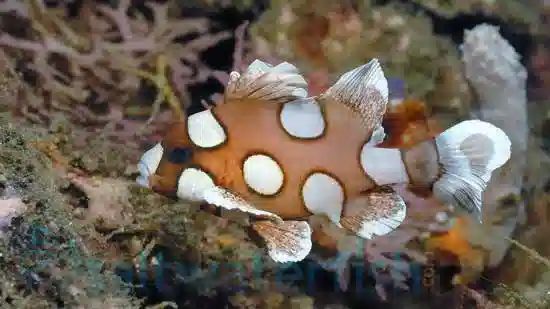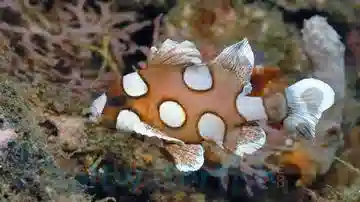Expert Only
Spotted Sweetlips
Plectorhinchus chaetodonoides
(3 Reviews)

Expert Only
Spotted Sweetlips
Plectorhinchus chaetodonoides
(3 Reviews)
{{ item.name }}
Size: {{ item.extra_field_3 }}
${{ getFormattedPrice(item.saleprice) }} ${{ getFormattedPrice(item.price) }}
To join the waiting list, click here
Free Shipping
With
$199.00
or more in Marine Life.
More details...
Spotted Sweetlips Care Facts
| Care Level: | Expert |
|---|---|
| Temperament: | Semi-Aggressive |
| Diet: | Carnivore |
| Reef Safe: | No |
| Minimum Tank Size: | 250 gallons |
| Max Size: | 24 inches |
Spotted Sweetlips (Plectorhinchus chaetodonoides) - Mesmerizing Addition to Saltwater Marine Aquariums
The Spotted Sweetlips (Plectorhinchus chaetodonoides) stand out as a mesmerizing and engaging species for enthusiasts seeking a captivating addition to their saltwater marine aquariums. This description provides an informative guide for those interested in welcoming this unique marine fish into their aquatic habitat.
Spotted Sweetlips Habitat:
Originating from the Indo-Pacific region, the Spotted Sweetlips are commonly found in the coral-rich waters of the ocean. Its natural habitat consists of shallow coastal reefs and lagoons, where it thrives amidst the vibrant marine life.
Reef Compatibility of Spotted Sweetlips:
The Spotted Sweetlips is not considered reef-safe, making it an excellent choice for FOWLR aquariums. It exhibits a moderate temperament, minimizing the risk of disturbance to the reef ecosystem.
Size and Lifespan of Spotted Sweetlips:
As a juvenile, the Spotted Sweetlips boasts a modest size, making it suitable for smaller aquariums. However, it undergoes substantial growth, reaching an impressive size of up to 24 inches in adulthood. With proper care, these magnificent fish can live for a decade or more, offering aquarium enthusiasts a long-term companion.
Diet of Spotted Sweetlips in Captivity:
Feeding the Spotted Sweetlips is a straightforward process. They are omnivores, readily accepting a diet of high-quality marine pellets, frozen foods like brine and mysis shrimp, and, occasionally, live foods. Ensuring a diverse diet contributes to their overall health and vibrancy.
Aquaculture Availability of Spotted Sweetlips:
As of the latest information, the Spotted Sweetlips are not extensively aquacultured for the aquarium trade. However, its availability may vary, and diligent inquiries with reputable suppliers can provide insight into its current market presence.
Compatibility with Other Fish and Invertebrates:
The Spotted Sweetlips is generally peaceful, making it compatible with various tankmates. Avoid aggressive or territorial species, and opt for companions with similar temperaments. Popular choices include tangs, butterflyfish, and peaceful wrasses.
Sexual Dimorphism in Spotted Sweetlips:
Sexual dimorphism in Spotted Sweetlips is not easily discernible by visual observation. Males and females generally exhibit similar external characteristics, making it easier to differentiate between the sexes with closer examination.
Juvenile to Adult Coloration Changes in Spotted Sweetlips:
Juvenile Spotted Sweetlips exhibit a striking contrast of black and white spots against a silvery-blue background, mimicking the appearance of a convict's uniform. As they mature, their coloration transforms into a more subdued pattern, featuring a brownish-grey body with subtle spots.
Temperament of Spotted Sweetlips:
Known for their calm and peaceful demeanor, Spotted Sweetlips are an excellent addition to community aquariums. They are not territorial and generally coexist harmoniously with a variety of tankmates.
Tank Requirements for Spotted Sweetlips:
Providing an adequate environment for the Spotted Sweetlips involves specific considerations. A minimum tank size of 250 gallons is recommended to accommodate their adult size comfortably. Maintain a well-established and stable aquarium with plenty of hiding spots and open swimming space.
- Minimum tank size of 250 gallons
- Adequate hiding spots and open swimming spaces
- Live rock structures for hiding and exploration
- Maintain a stable environment with proper filtration
Water Conditions for Spotted Sweetlips:
- pH: Maintain a pH level between 8.1 and 8.4
- Salinity at 1.020 to 1.025
- Water temperature between 74 to 78 degrees Fahrenheit
- Moderate water flow to mimic the gentle currents in their natural habitat
Common Names of Spotted Sweetlips:
The Spotted Sweetlips are known by various names, including Harlequin Sweetlips and Clown Sweetlips.
Five Compatible Tank Mates for Spotted Sweetlips:
- Emperor Angelfish (Pomacanthus imperator)
- Copperband Butterflyfish (Chelmon rostratus)
- Blue Tang (Paracanthurus hepatus)
- Flame Hawkfish (Neocirrhites armatus)
- Large Wrasses (Various Species)
Why Choose Spotted Sweetlips from Saltwaterfish.com:
Purchasing your Spotted Sweetlips from Saltwaterfish.com ensures a reliable source for healthy and well-acclimated specimens. With a commitment to sustainable and ethical practices, Saltwaterfish.com provides a diverse selection of marine species backed by expert guidance and exceptional customer service. Choose quality and reliability when adding the Spotted Sweetlips to your aquarium, and trust Saltwaterfish.com for a seamless acquisition experience.
In conclusion, the Spotted Sweetlips are an intriguing and visually stunning choice for saltwater marine aquariums. With the proper care, a harmonious community, and attention to specific tank requirements, this species can thrive and become a captivating focal point in any enthusiast's underwater haven.
Expert Only: Items designated as expert only require special care such as a species specific environment, special diet or care, and an expert level, experienced aquarist. Not for beginners. Expert Only items qualify for our live arrival guarantee only, and are exempt from our extended 8 day guarantee.
Very peaceful very active fish
Reviewed by: Karen Mcgregor on Nov. 1, 2017
Our sweetlips came in wonderfully, however I have a feeling it got to close to the LTA one night, as it was gone the next day no body no fish. Will re-order, it was very beautiful.
Reviewed by: Forrest Nelson on Oct. 4, 2017
Always thought this was a great fish when you get them a bit on the small side. The specimen that I received is eating and doing it's clownfish like dance.
Reviewed by: Kenneth Goldsmith on July 4, 2017
Recommendations
Currently not available.











